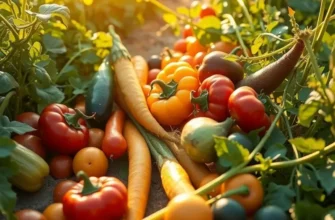Understanding the power of food is the first step to better health. Anti-inflammatory foods not only support your well-being but also help reduce chronic inflammation. By incorporating these vibrant nutrients into your diet, you can enhance overall health while enjoying delicious meals. Let’s explore the fantastic world of foods that fight inflammation, providing both taste and nutrition in every bite.
Fruits and Vegetables: Nature’s Healing Armor

Fruits and vegetables sit at the core of any anti-inflammatory diet, offering an abundance of vitamins, minerals, and antioxidants. These natural warriors work tirelessly to combat inflammation, making them indispensable in our quest for health. Not all fruits and vegetables are created equal, though. Understanding which ones pack the most punch can help tailor your daily nutrition effectively.
Bright Berries: Blueberries and More
Blueberries, known for their vibrant color and juicy taste, are a powerhouse of anti-inflammatory compounds, specifically polyphenols. These antioxidants help reduce oxidative stress and lower inflammation. Incorporate blueberries into smoothies, yogurt, or oatmeal. To diversify, consider strawberries and raspberries, equally rich in antioxidants and very versatile.
Leafy Greens: Nutrient-Dense Powerhouses
Spinach, kale, and other leafy greens are excellent sources of vitamin E, which can help protect the body from inflammatory molecules. They’re also packed with omega-3 fatty acids. Try adding baby spinach to your salads or blending kale into green smoothies. Sautéing greens with a drizzle of olive oil and garlic can make a delightful side dish.
Cruciferous Vegetables: The Daily Detox
Broccoli and Brussels sprouts, both members of the cruciferous family, offer sulforaphane, an antioxidant with potent anti-inflammatory effects. Roasted or sautéed, they bring texture and deep flavor to any meal. Adding shredded broccoli to a stir-fry or roasting Brussels sprouts enhances both nourishment and taste.
Tart Cherries: Nature’s Pain Reliever
Tart cherries have become popular for their unique ability to minimize inflammation and reduce pain. Rich in anthocyanins, they can be enjoyed fresh or as tart cherry juice. Including them in your post-workout recovery can contribute significantly to easing muscle soreness.
Bright and Citrus Fruits: A Boost of Vitamin C
Oranges and lemons shine brightly with their vitamin C content, which is critical for immune function and lowering inflammation. Adding sections of fresh orange to a salad or a squeeze of lemon over your dishes not only boosts your vitamin intake but adds a refreshing zest.
Tomatoes: Multitudinous Benefits
While some might avoid tomatoes due to diet specifications like nightshade-free diets, these nutrient-rich fruits are loaded with lycopene, known for its anti-inflammatory properties. Cooking tomatoes increases their lycopene content, making tomato sauces a nourishing addition to pastas and stews. Explore ways to cook without certain ingredients to suit dietary preferences.
Introducing more fruits and vegetables into your diet doesn’t have to be tedious. Small changes, such as snacking on brightly colored fruits or adding a side of roasted vegetables, can significantly impact your body’s fight against inflammation.
Whole Grains and Healthy Fats: The Foundation of Anti-Inflammatory Diets

Incorporating whole grains and healthy fats into your diet is a strategic move towards reducing inflammation. Whole grains are rich in fiber, vitamins, and minerals, making them a staple for those focused on health. Options like quinoa, brown rice, oats, and barley offer a range of nutrients vital for reducing inflammation. These grains stabilize blood sugar levels and promote digestive health, contributing to an overall balanced diet.
Whole grains contain antioxidants, which combat oxidative stress, a contributor to inflammation. Beta-glucan in oats is known for its cholesterol-lowering effects, which can indirectly reduce inflammation in the cardiovascular system. When building meals, choose whole grains as your base, enhancing them with colorful vegetables and lean proteins.
Healthy fats, particularly omega-3 fatty acids, play a critical role in decreasing inflammation. Found in high concentrations in fatty fish, flaxseeds, and walnuts, omega-3s are essential for heart and brain health. These fats help counteract the effects of pro-inflammatory omega-6 fatty acids, common in many processed foods. Consuming a balance of omega-3 and omega-6 is crucial for reducing inflammation markers in the body,
Avocados and olive oil also provide healthy fats with additional benefits. Avocados are rich in monounsaturated fats that help improve cholesterol levels and decrease inflammation. Olive oil, especially extra virgin, is rich in antioxidants and anti-inflammatory compounds like oleocanthal.
A practical approach to meal planning includes pairing these anti-inflammatory ingredients creatively. Start the day with oatmeal topped with nuts and seeds. For lunch, enjoy a quinoa salad with olive oil dressing and mixed greens. Dinner can feature grilled salmon with brown rice and a side of sautéed leafy greens. This way, you enjoy variety while nourishing your body with foods that reduce inflammation.
Incorporating these components into your meals can be simple with a few strategies. Batch cooking whole grains and pre-prepping healthy fats can streamline meal creation and save time. Storing your grains properly will also help maintain their nutrient profile over time. For more on reducing food waste and efficient storage practices, consider exploring our guide on eco-smart kitchen storage.
Transitioning to a diet rich in whole grains and healthy fats is both delicious and rewarding. It requires mindfulness and a commitment to making informed choices, yet the health benefits make it worthwhile. Keep experimenting with different grains and healthy fats to find combinations that delight your palate while supporting your wellness journey.
Final words
Embracing an anti-inflammatory diet can be a delicious journey towards better health. By focusing on a variety of fruits, vegetables, whole grains, and healthy fats, you can savor the flavors of health-giving foods while actively combatting inflammation. Remember, small changes in your dietary habits can lead to significant improvements in your overall well-being. Let’s celebrate the joys of eating nourishing foods that help our bodies thrive!







